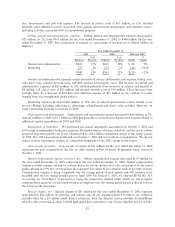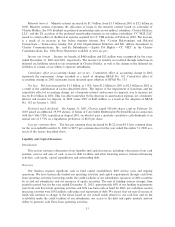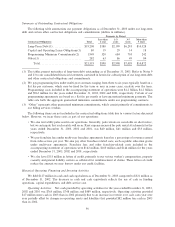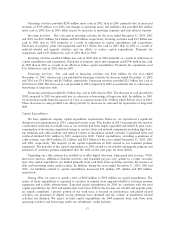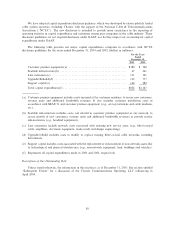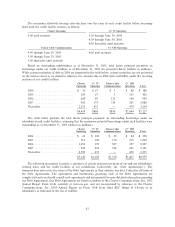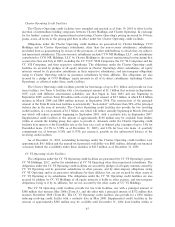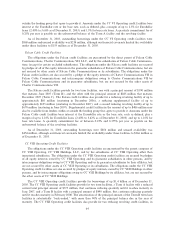Charter 2003 Annual Report Download - page 56
Download and view the complete annual report
Please find page 56 of the 2003 Charter annual report below. You can navigate through the pages in the report by either clicking on the pages listed below, or by using the keyword search tool below to find specific information within the annual report.We have a signiÑcant level of debt. In 2004, $188 million of our debt matures, and in 2005 and 2006, an
additional $1.0 billion and $1.2 billion matures, respectively. In subsequent years, substantial additional
amounts will become due under our remaining obligations. As the principal amounts owing under our various
debt obligations become due, sustaining our liquidity will likely depend upon our ability to access additional
sources of capital over time. A default under the covenants governing any of our debt instruments could result
in the acceleration of our payment obligations under that debt and, under certain circumstances, in cross-
defaults under our other debt obligations, which would have a material adverse eÅect on our consolidated
Ñnancial condition or results of operations.
As part of our plan to sell certain non-strategic assets, on October 1, 2003, we completed the sale of our
Port Orchard, Washington system for approximately $91 million, subject to adjustments. Additionally, on
March 1, 2004, Charter Holdings and several of its subsidiaries closed the sale of cable systems in Florida,
Pennsylvania, Maryland, Delaware and West Virginia. An additional closing for a cable system in New York
occurred in April 2004. Subject to post-closing contractual adjustments, the Company expects the total net
proceeds from the sale of all these systems to be approximately $733 million, of which $10 million is currently
held in an indemnity escrow account (with the unused portion thereof to be released by March 1, 2005). The
net proceeds received to date have been used to repay a portion of amounts outstanding under subsidiary credit
facilities.
In September 2003, CCH II, Charter and Charter Holdings purchased, in a non-monetary transaction, a
total of approximately $609 million principal amount of Charter's convertible senior notes and approximately
$1.3 billion principal amount of the senior notes and senior discount notes issued by Charter Holdings from
institutional investors in a small number of privately negotiated transactions. As consideration for these
securities, CCH II issued approximately $1.6 billion principal amount of 10.25% senior notes due 2010,
achieving approximately $294 million of debt discount. The transactions were eÅected through a distribution
of equity by CCH II to Charter and Charter Holdings. CCH II also issued an additional $30 million principal
amount of 10.25% senior notes for cash and used the proceeds for transaction costs and for general corporate
purposes. As a result of the transaction, a $267 million gain was recorded and maturities were extended for a
majority of the debt exchanged. Also, in November 2003, CCO Holdings sold $500 million total principal
amount of 8∂% senior notes due 2013, the proceeds of which were used to repay (but not to reduce
permanently) amounts outstanding under our subsidiaries' bank credit facilities.
We are currently in compliance with the covenants under the credit facilities of our subsidiaries and our
indentures and those of our subsidiaries, and we expect to remain in compliance with those covenants
throughout 2004. If our actual operating results do not result in compliance with these covenants, or if other
events of noncompliance occur, funding under the credit facilities may not be available and defaults on some
or potentially all debt obligations could occur. However, we expect that our cash on hand, cash Öows from
operating activities, proceeds from the completion of the sale of certain non-strategic assets in the Ñrst quarter
of 2004 and the amounts available under our subsidiaries' credit facilities should be suÇcient to satisfy our
liquidity needs through 2004. As of December 31, 2003, we held $127 million in cash and cash equivalents and
we had total potential unused availability of $1.7 billion under the credit facilities of our subsidiaries, although
the actual unused availability at year-end was $828 million because of limits imposed under covenant
restrictions. However, cash Öows from operating activities and amounts available under credit facilities may
not be suÇcient to permit us to satisfy our principal repayment obligations scheduled to come due in 2005 and
thereafter. Our signiÑcant amount of debt may negatively aÅect our ability to access additional capital in the
future. In addition, the maximum allowable leverage ratios under our credit facilities will decline over time
and the total potential borrowing available under our subsidiaries' current credit facilities (subject to covenant
restrictions and limitations) will decrease from approximately $9.0 billion as of the end of 2003 to
approximately $8.7 billion and approximately $7.7 billion by the end of 2004 and 2005, respectively.
Continued access to these credit facilities is subject to our remaining in compliance with the applicable
covenants of these credit facilities, including covenants tied to our operating performance. If there is an event
of default under our subsidiaries' credit facilities, such as the failure to maintain the applicable required
Ñnancial ratios, we would be unable to borrow under these credit facilities, which could materially adversely
impact our ability to operate our business and to make payments under our debt instruments.
54





